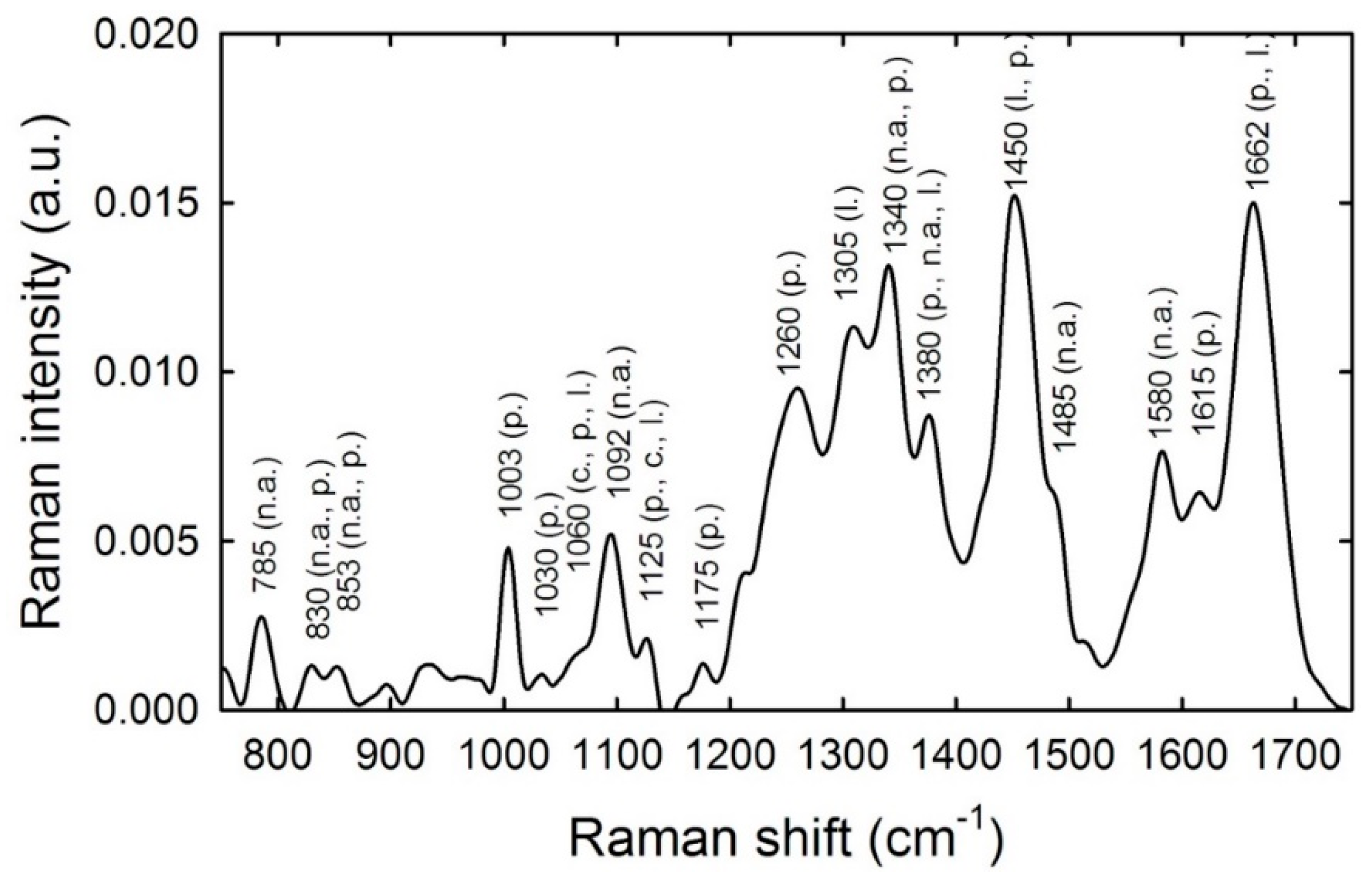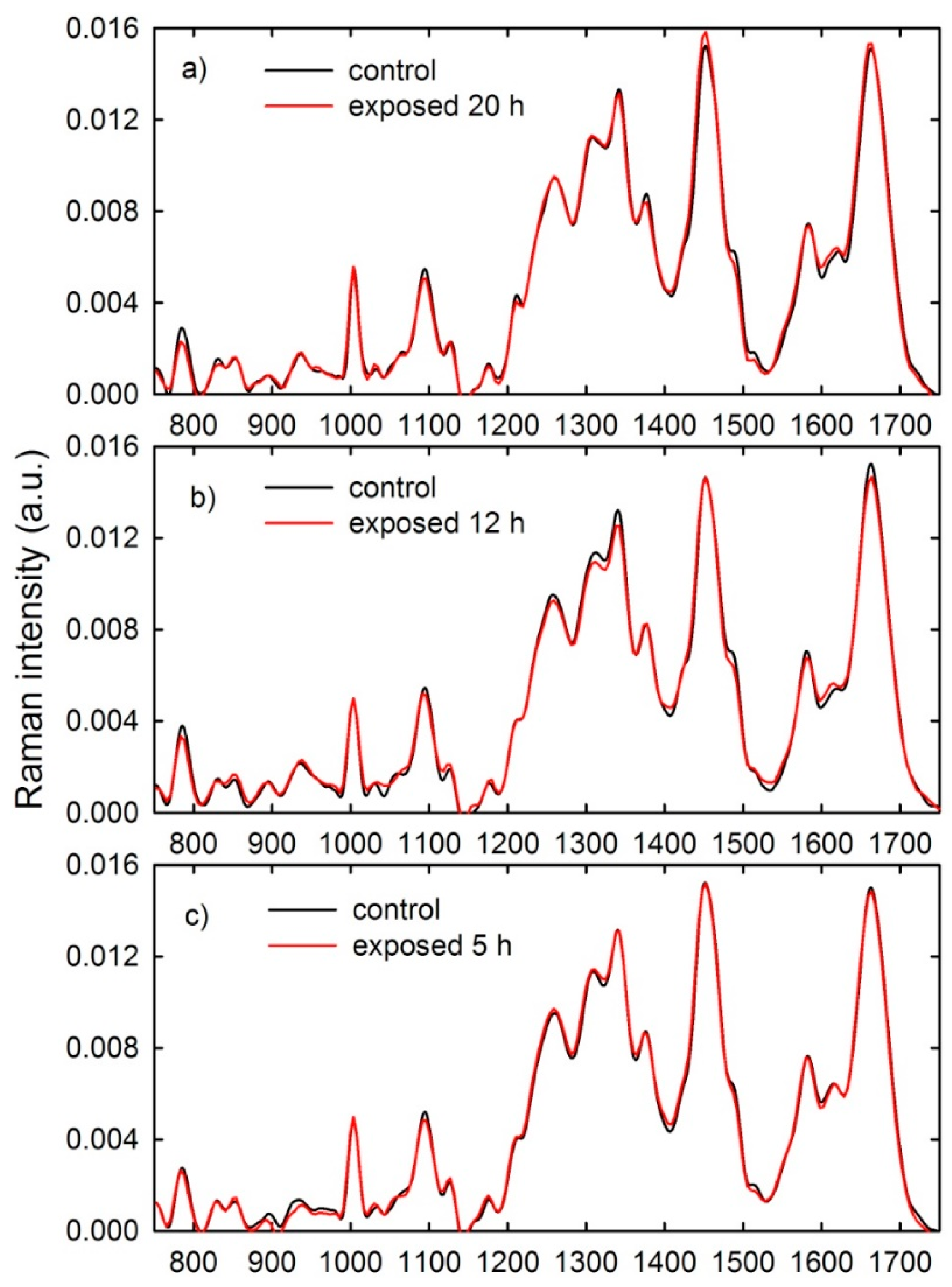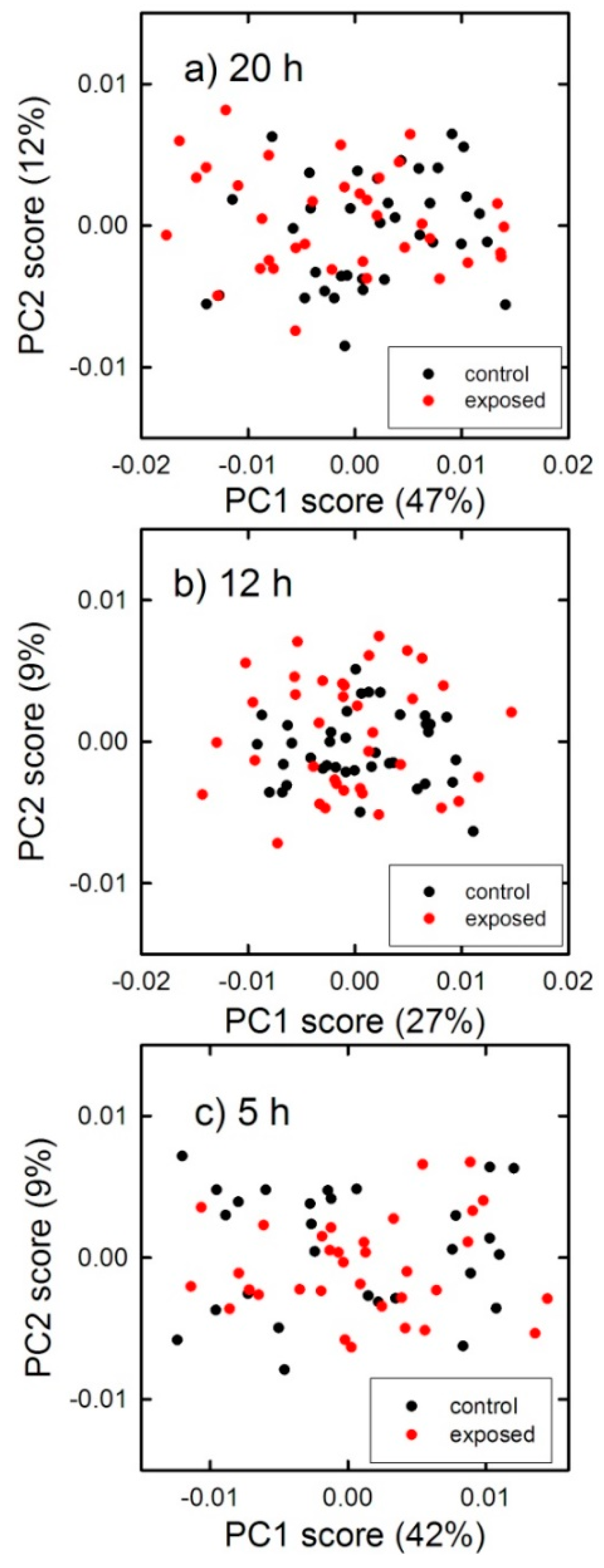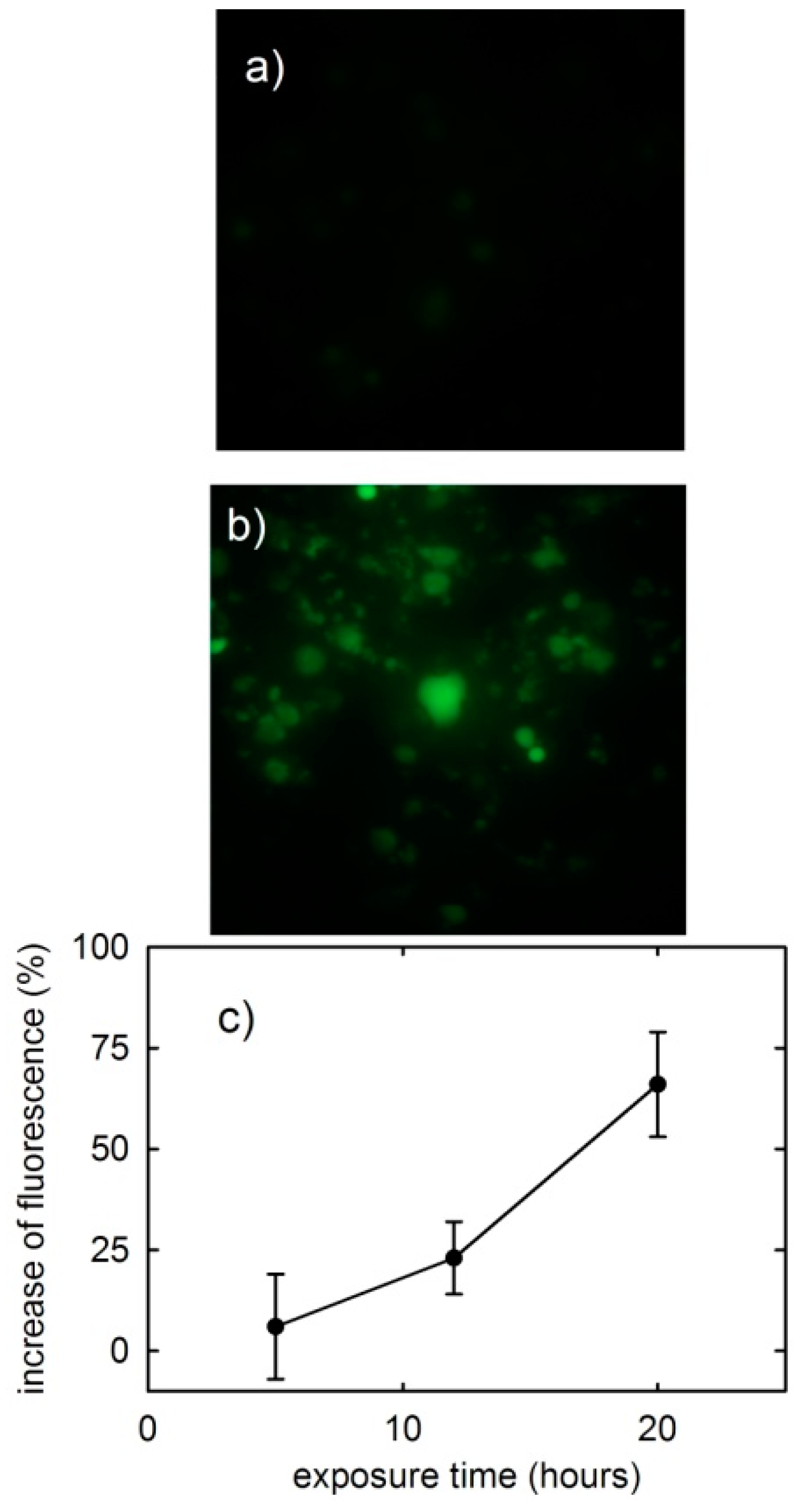DNA-Related Modifications in a Mixture of Human Lympho-Monocyte Exposed to Radiofrequency Fields and Detected by Raman Microspectroscopy Analysis
Abstract
:Featured Application
Abstract
1. Introduction
2. Materials and Methods
2.1. Blood Collection and EMFs Exposure
2.2. Isolation of Lympho-Monocyte Cells
2.3. Raman Microspectroscopy and Spectra Processing
2.4. ROS Analysis
3. Results and Discussion
4. Conclusions
Author Contributions
Funding
Acknowledgments
Conflicts of Interest
References
- Camara, P.R.S. Effect of exposure to non-ionizing radiation (electromagnetic fields) on the human system: A literature review. J. Interdiscip. Histopathol. 2014, 2, 187–190. [Google Scholar] [CrossRef]
- Romanenko, S.; Begley, R.; Harvey, A.R.; Hool, L.; Wallace, V.P. The interaction between electromagnetic fields at megahertz, gigahertz and terahertz frequencies with cells, tissues and organisms: Risks and potential. J. R. Soc. Interface 2017, 14, 20170585. [Google Scholar] [CrossRef] [PubMed]
- Campisi, A.; Gulino, M.; Acquaviva, R.; Bellia, P.; Raciti, G.; Grasso, R.; Musumeci, F.; Vanella, A.; Triglia, A. Reactive oxygen species levels and DNA fragmentation on astrocytes in primary culture after acute exposure to low intensity microwave electromagnetic field. Neurosci. Lett. 2010, 473, 52–55. [Google Scholar] [CrossRef] [PubMed]
- Sun, C.; Wei, X.; Fei, Y.; Su, L.; Zhao, X.; Chen, G.; Xu, Z. Mobile phone signal exposure triggers a hormesis-like effect in ATM+/+ and Atm-/- mouse embryonic fibroblasts. Sci. Rep. 2016, 6, 37423. [Google Scholar] [CrossRef] [PubMed]
- Galli, C.; Pedrazzi, G.; Guizzardi, S. The cellular effects of Pulsed Electromagnetic Fields on osteoblasts: A review. Bioelectromagnetics 2019, 40, 211–233. [Google Scholar] [CrossRef]
- Sannino, A.; Zeni, O.; Romeo, S.; Massa, R.; Scarfi, M.R. Adverse and beneficial effects in Chinese hamster lung fibroblast cells following radiofrequency exposure. Bioelectromagnetics 2017, 38, 245–254. [Google Scholar] [CrossRef]
- Xu, S.; Chen, G.; Chen, C.; Sun, C.; Zhang, D.; Murbach, M.; Kuster, N.; Zeng, Q.; Xu, Z. Cell Type-Dependent Induction of DNA Damage by 1800 MHz Radiofrequency Electromagnetic Fields Does Not Result in Significant Cellular Dysfunctions. PLoS ONE 2013, 8, e54906. [Google Scholar] [CrossRef]
- Saliev, T.; Begimbetova, D.; Masoud, A.-R.; Matkarimov, B. Biological effects of non-ionizing electromagnetic fields: Two sides of a coin. Prog. Biophys. Mol. Biol. 2019, 141, 25–36. [Google Scholar] [CrossRef]
- Tice, R.R.; Hook, G.G.; Donner, M.; McRee, D.I.; Guy, A.W. Genotoxicity of radiofrequency signals. I. Investigation of DNA damage and micronuclei induction in cultured human blood cells. Bioelectromagnetics 2002, 23, 113–126. [Google Scholar] [CrossRef]
- Mashevich, M.; Folkman, D.; Kesar, A.; Barbul, A.; Korenstein, R.; Jerby, E.; Avivi, L. Exposure of human peripheral blood lymphocytes to electromagnetic fields associated with cellular phones leads to chromosomal instability. Bioelectromagnetics 2003, 24, 82–90. [Google Scholar] [CrossRef]
- Kazemi, E.; Mortazavi, S.M.J.; Ali-Ghanbari, A.; Sharifzadeh, S.; Ranjbaran, R.; Mostafavi-Pour, Z.; Zal, F.; Haghani, M. Effect of 900 MHz Electromagnetic Radiation on the Induction of ROS in Human Peripheral Blood Mononuclear Cells. J. Biomed. Phys. Eng. 2015, 5, 105–114. [Google Scholar] [PubMed]
- Taheri, M.; Roshanaei, G.; Ghaffari, J.; Rahimnejad, S.; Khosroshahi, B.N.; Aliabadi, M.; Eftekharian, M.M. The effects of Base Transceiver Station waves on some immunological and hematological factors in exposed persons. Hum. Antibodies 2017, 25, 31–37. [Google Scholar] [CrossRef] [PubMed]
- Lasalvia, M.; Scrima, R.; Perna, G.; Piccoli, C.; Capitanio, N.; Biagi, P.F.; Schiavulli, L.; Ligonzo, T.; Centra, M.; Casamassima, G.; et al. Exposure to 1.8 GHz electromagnetic fields affects morphology, DNA-related Raman spectra and mitochondrial functions in human lympho-monocytes. PLoS ONE 2018, 13, e0192894. [Google Scholar] [CrossRef] [PubMed]
- Matthews, Q.; Brolo, A.G.; Lum, J.; Duan, X.; Jirasek, A. Raman spectroscopy of single human tumour cells exposed to ionizing radiation in vitro. Phys. Med. Biol. 2011, 56, 19–38. [Google Scholar] [CrossRef] [PubMed]
- Efeoglu, E.; Casey, A.; Byrne, H.J. In vitro monitoring of time and dose dependent cytotoxicity of aminated nanoparticles using Raman spectroscopy. Analyst 2016, 141, 5417–5431. [Google Scholar] [CrossRef] [PubMed] [Green Version]
- Batista de Cavalho, A.L.M.; Pilling, M.; Gardner, P.; Doherty, J.; Cinque, G.; Wehbe, C.; Kelley, C.; Batista de Carvalho, L.A.E.; Marques, M.P.M. Chemoterapeutic response to cisplatin-like drugs in human breast cancer cells probed by vibrational microspectroscopy. Faraday Discuss. 2016, 187, 273–298. [Google Scholar] [CrossRef] [PubMed]
- Knief, P.; Keating, M.E.; Bonnier, F.; Byrne, H.J. Spectral pre and post processing for infrared and Raman spectroscopy of biological tissues and cells. Chem. Soc. Rev. 2016, 45, 1865–1878. [Google Scholar]
- Bonnier, F.; Byrne, H.J. Understanding the molecular information contained in principal component analysis of vibrational spectra of biological systems. Analyst 2012, 137, 322–332. [Google Scholar] [CrossRef] [PubMed]
- International Commission on Non-Ionizing Radiation Protection (ICNIRP). Guidelines for Limiting Exposure to Time-varying Electric, Magnetic and Electromagnetic Fields (up to 300 GHz). Health Phys. 1998, 74, 494–522. [Google Scholar]
- Poljak, D. Human Exposure to Electromagnetic Fields; WIT Press: Cambridge, MA, USA, 2004; Ch. 6. [Google Scholar]
- ISO. International Standard ISO 6710 Single-Use Containers for Venous Blood Specimen Collection; ISO: Geneva, Switzerland, 2017. [Google Scholar]
- Biagi, P.F.; Righetti, F.; Maggipinto, T.; Maggipinto, G.; Ligonzo, T.; Schiavulli, L.; LoIacono, D.; Casamassima, G.; De Carne, G.; Laterza, G.; et al. Apparatus for “in vivo” exposure at 1.8 GHz microwaves. J. Instrum. 2011, 6, T07002. [Google Scholar] [CrossRef]
- Biagi, P.F.; Castellana, L.; Maggipinto, T.; Maggipinto, G.; Ligonzo, T.; Schiavulli, L.; LoIacono, D.; Ermini, A.; Lasalvia, M.; Perna, G.; et al. A reverberation chamber to investigate the possible effects of “in vivo” exposure of rats to 1.8 ghz electromagnetic fields: A preliminary study. Prog. Electromagn. Res. 2009, 94, 133–152. [Google Scholar] [CrossRef]
- Hanson, B.A. ChemoSpec: Exploratory Chemometrics for Spectroscopy. R Package Version 4.4.97. 2017. Available online: https://CRAN.R-project.org/package=ChemoSpec (accessed on 1 March 2019).
- Wojtala, A.; Bonora, M.; Malinska, D.; Pinton, P.; Duszynski, J.; Wieckowski, M.R. Methods to monitor ROS production by fluorescence microscopy and fluorometry. Methods Enzymol. 2014, 542, 243–262. [Google Scholar] [PubMed]
- Movasaghi, Z.; Rehman, S.; Rehman, I.U. Raman Spectroscopy of Biological Tissues. Appl. Spectrosc. Rev. 2007, 42, 493–541. [Google Scholar] [CrossRef]
- Fore, S.; Chan, J.; Taylor, D.; Huser, T. Raman spectroscopy of individual monocytes reveals that single-beam optical trapping of mononuclear cells occurs by their nucleus. J. Opt. 2011, 13, 044021. [Google Scholar] [CrossRef] [PubMed] [Green Version]
- Kumagai, Y.; Hobro, A.J.; Akira, S.; Smith, N.I. Raman spectroscopy as a tool for label-free lymphocyte cell line discrimination. Analyst 2016, 141, 3756–3764. [Google Scholar]
- Zinin, P.V.; Misra, A.; Kamemoto, L.; Yu, Q.; Hu, N.; Sharma, S.K. Visible, near-infrared and ultraviolet laser-excited Raman spectroscopy of the monocytes/macrophages (U937) cells. J. Raman Spectr. 2010, 41, 268–274. [Google Scholar] [CrossRef]
- Zothansiama; Zosangzuali, M.; Lalramdinpuii, M.; Jagetia, G.C. Impact of radiofrequency radiation on DNA damage and antioxidants in peripheral blood lymphocytes of humans residing in the vicinity of mobile phone base stations. Electromagn. Biol. Med. 2017, 36, 295–305. [Google Scholar] [CrossRef] [PubMed]
- Blank, M.; Goodman, R. A mechanism for stimulation of biosynthesis byelectromagnetic fields: Charge transfer in DNA and base pair separation. J. Cell. Physiol. 2008, 214, 20–26. [Google Scholar] [CrossRef]
- Brauchle, E.; Thude, S.; Brucker, S.Y.; Schenke-Layland, K. Cell death stages in single apoptotic and necrotic cells monitored by Raman microspectroscopy. Sci. Rep. 2014, 4, 4698. [Google Scholar] [CrossRef] [Green Version]
- Menon, R.; Taylor, R.N.; Urrabaz-Garza, R.; Kechichian, T.; Syed, T.A.; Papaconstantinou, J.; Saade, G.; Boldogh, I. Reactive oxygen species (ROS) induce DNA damage and senescence in human amniochorionic membranes and amnion cells. Reprod. Sci. 2013, 20, 239a. [Google Scholar]
- Uzunboy, S.; Cekic, S.D.; Apak, R. Determination of reactive oxygen species induced dna damage using modified cupric reducing antioxidant capacity (CUPRAC) colorimetric method. FEBS J. 2016, 283, 397–398. [Google Scholar]
- Wells, P.G.; Miller-Pinsler, L.; Bhatia, S.; Drake, D.; Shapiro, A.M. Reactive oxygen species (ROS) formation, oxidative DNA damage and repair in teratogenesis. Birth Defects Res. Part A Clin. Mol. Teratol. 2015, 103, 359. [Google Scholar]





| Spectral Range of Raman Features (cm−1) [26] | Present Work (cm−1) | Attribution |
|---|---|---|
| 780–788 | 785 | (O-P-O str., n.a.) + (ring breathing, n.a.) |
| 810–859 | 830, 853 | (O-P-O str., n.a.) + (ring breathing, Tyr.) |
| 895, 932, 970 | vibrational modes of glass substrate | |
| 1000–1006 | 1003 | (symmetric ring breathing, Phe) |
| 1031–1033 | 1030 | (C-H in-plane bend., Phe) |
| 1053–1064 | 1060 | (C-O C-C, c.) + (C-N str., p.) + (C-C str., l.) |
| 1087–1096 | 1092 | ( str., n. a.) |
| 1123–1128 | 1125 | (C-N str., p.) + (C-O, c.) + (C-C str., l.) |
| 1163–1176 | 1175 | (C-H bending, Tyr) |
| 1220–1284 | 1260 | (Amide III, p.) |
| 1300–1313 | 1305 | (CH2 twist., l.) |
| 1335–1343 | 1340 | (CH3 def., CH2 wagg., p. and n.a.) |
| 1360–1379 | 1380 | (CH bend., Trp) + (ring breathing, n.a.) + (CH3 bend., l.) |
| 1436–1460 | 1450 | (CH2 sciss., l.) + (CH2 sciss., p.) |
| 1485–1490 | 1485 | (ring breathing, n.a.) |
| 1573–1582 | 1580 | (ring breathing, n.a.) |
| 1615–1618 | 1615 | (C=C, Tyr., Trp.) |
| 1655–1685 | 1662 | (Amide I, p.) + (C=C str., l.) |
© 2019 by the authors. Licensee MDPI, Basel, Switzerland. This article is an open access article distributed under the terms and conditions of the Creative Commons Attribution (CC BY) license (http://creativecommons.org/licenses/by/4.0/).
Share and Cite
Lasalvia, M.; Perna, G.; Capozzi, V. DNA-Related Modifications in a Mixture of Human Lympho-Monocyte Exposed to Radiofrequency Fields and Detected by Raman Microspectroscopy Analysis. Appl. Sci. 2019, 9, 3700. https://doi.org/10.3390/app9183700
Lasalvia M, Perna G, Capozzi V. DNA-Related Modifications in a Mixture of Human Lympho-Monocyte Exposed to Radiofrequency Fields and Detected by Raman Microspectroscopy Analysis. Applied Sciences. 2019; 9(18):3700. https://doi.org/10.3390/app9183700
Chicago/Turabian StyleLasalvia, Maria, Giuseppe Perna, and Vito Capozzi. 2019. "DNA-Related Modifications in a Mixture of Human Lympho-Monocyte Exposed to Radiofrequency Fields and Detected by Raman Microspectroscopy Analysis" Applied Sciences 9, no. 18: 3700. https://doi.org/10.3390/app9183700





